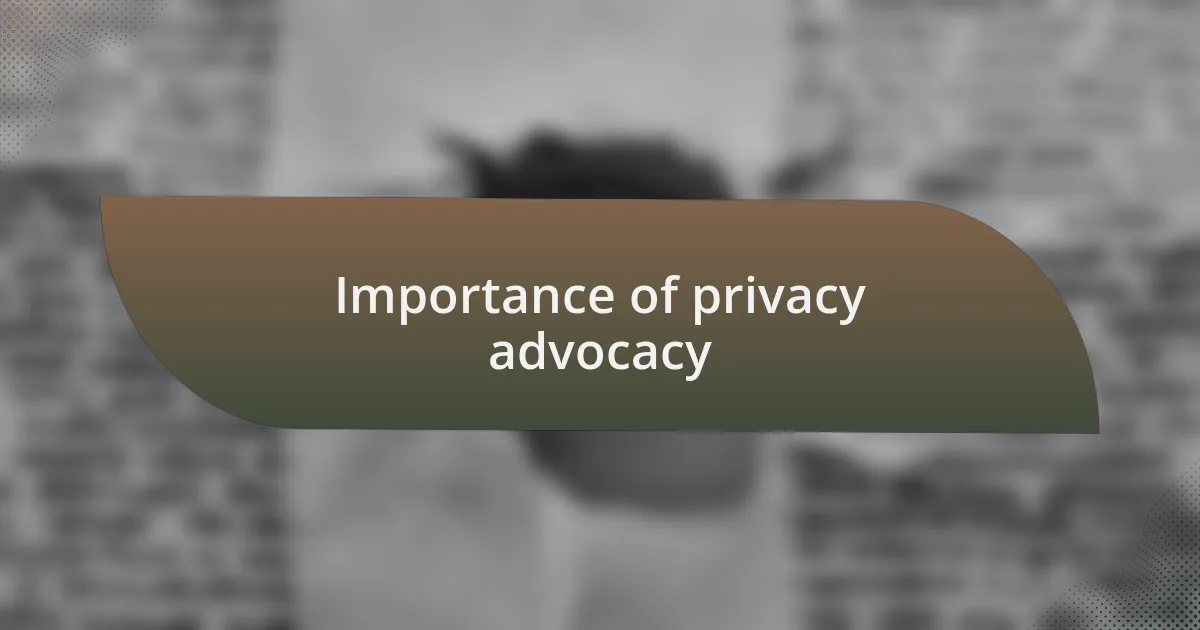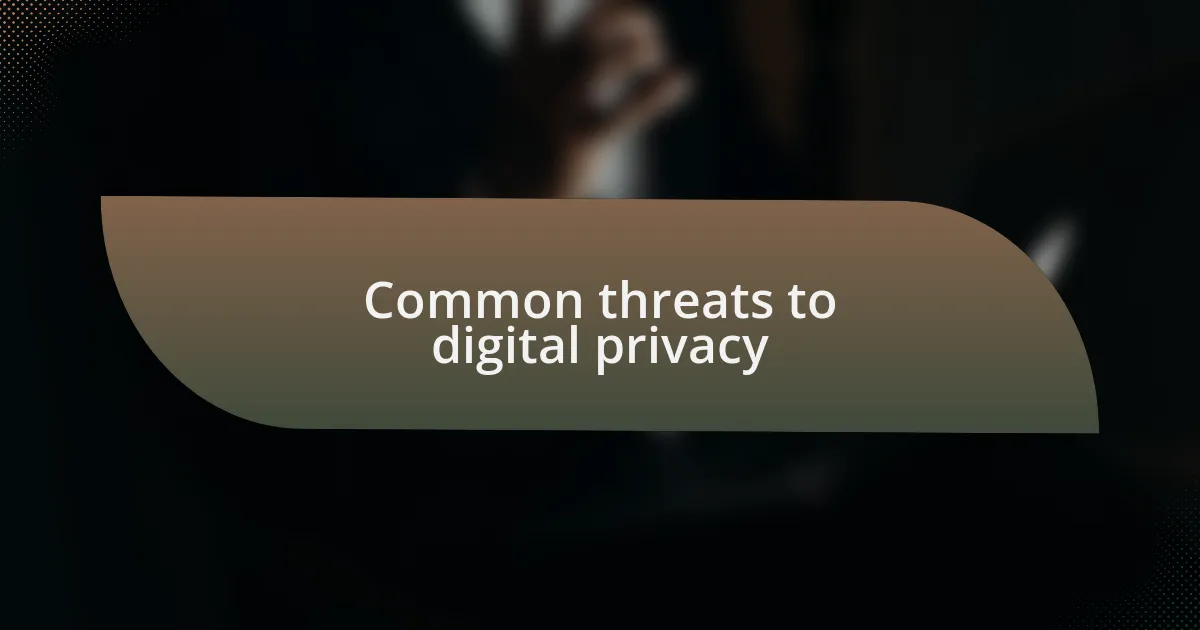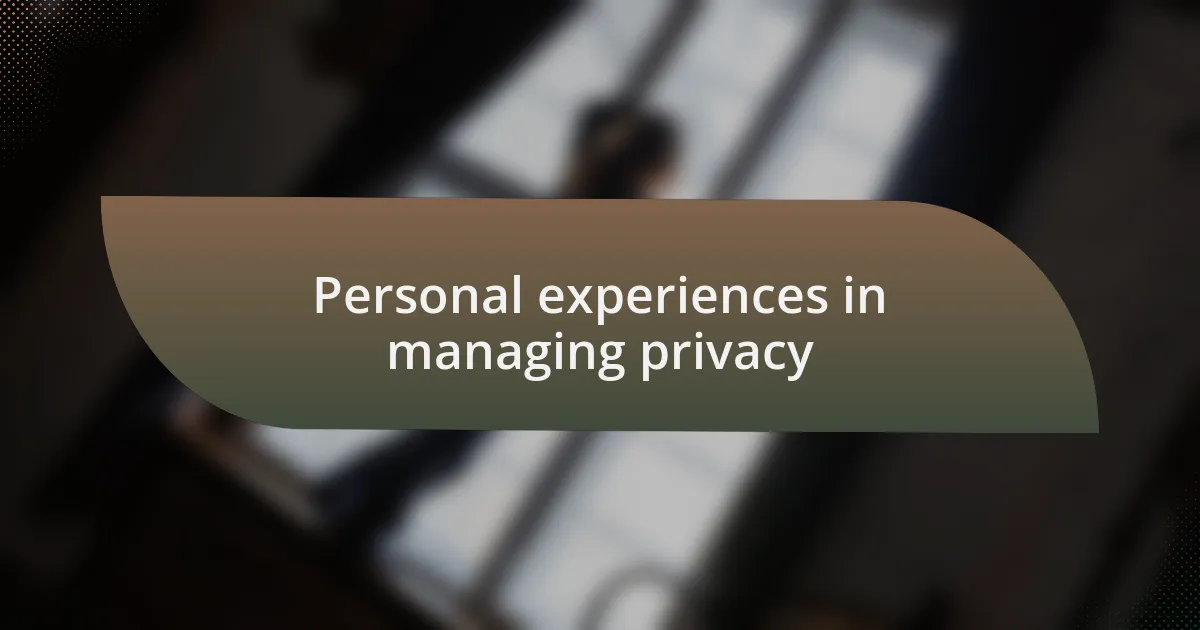Key takeaways:
- Digital footprints are created through online actions like likes, shares, and searches, influencing personal and professional opportunities.
- Privacy advocacy empowers individuals to control their personal information and raises awareness about data usage by companies.
- Common threats to digital privacy include identity theft, tracking cookies, and phishing attacks, emphasizing the need for vigilance.
- Regularly assessing and managing one’s online presence, including privacy settings and content shared, is crucial for protecting personal information.

Understanding digital footprint
It’s fascinating how our online actions shape a digital footprint that tells our story. When I first learned about digital footprints, I was surprised to find that every like, share, and comment I made contributed to this invisible trail. Have you ever thought about what your social media profiles say about you?
Consider this: even seemingly innocent searches or online purchases accumulate, creating a detailed picture of our preferences and habits. I remember the day I realized a simple Google search for hiking gear led to targeted ads that felt a bit too personal, making me wonder who else might be watching. It’s a stark reminder that this trail doesn’t just belong to us; it can be analyzed, shared, and sometimes even exploited.
Understanding our digital footprint is crucial because it influences everything from job opportunities to personal relationships. I was once startled to discover my online presence had resurfaced during a job interview. They didn’t just view my resume; they had digital insights into my interests and past activities. This realization drove me to actively manage what I put out there, but it also left me wondering: how much of me is really out there, and in whose hands?

Importance of privacy advocacy
Privacy advocacy is essential because it empowers individuals to take control of their personal information. I remember the first time I received a notification about a data breach affecting a company I had trusted. It was unsettling to think that my personal details might be floating around in the wrong hands, prompting me to understand the importance of safeguarding my data.
Moreover, advocating for privacy helps raise awareness about how companies use our information. I once attended a seminar where the speaker revealed the extent of data collection through everyday apps. It was eye-opening to realize that my everyday activities could be monetized without my explicit consent. How can we expect to maintain our autonomy if we aren’t even aware of how our data is used?
Furthermore, privacy advocacy fosters a culture where individuals demand transparency and accountability from organizations. During a recent discussion with friends, we all shared our ongoing struggles with privacy settings on social media. It struck me that the more we talk about these issues, the more empowered we feel to challenge platforms to prioritize our privacy. Isn’t it time we put a spotlight on the right to control our own narratives?

Common threats to digital privacy
Digital privacy threats are more common than many realize. I recall a time when I clicked on an innocuous-looking link from an email, thinking it was safe. What followed was a whirlwind of identity theft that left me scrambling to regain control over my accounts. Have you ever considered how easily that could happen to anyone?
Another significant threat is the pervasive nature of tracking cookies. These tiny pieces of data continue to follow our online behavior, often without our permission. I remember feeling a mix of frustration and violation after discovering just how much my browsing habits were being collected when I checked a site that analyzed my digital footprint. It made me wonder—if I’m not aware of this constant surveillance, how can I effectively protect my privacy?
Additionally, phishing attacks present a constant challenge, exploiting our trust in digital communication. I once received a message that appeared to be from my bank, prompting me to confirm my details. The suspense of almost falling for that scam taught me to verify sender legitimacy before divulging sensitive information. Have you ever paused to double-check an email before responding? That one extra moment of vigilance can mean the difference between security and a breach.

Assessing your online presence
Taking the time to assess your online presence can be eye-opening. I recently decided to conduct a thorough audit of my social media accounts. What shocked me was discovering content I had completely forgotten about, like an old post from years ago that no longer reflects my views. Have you ever stumbled upon something in your digital history that made you cringe?
It’s important to search your name and email to see what others can find. I remember doing a simple Google search and finding old forum threads where I had shared personal opinions. It was a reminder of how easily information can linger online, even when we think we’ve moved on. Does it concern you to think about how much of your life is archived and accessible to anyone?
Moreover, I’ve started monitoring privacy settings on my accounts regularly. After adjusting these settings, I felt a sense of empowerment, like I was taking back control over my information. It made me wonder—what would it take for you to start reassessing your own digital footprint? Taking these steps is crucial in a world where our information is often scattered and vulnerable.

Strategies to manage your footprint
One effective strategy I employed was to delete old accounts that I no longer use. I remember the relief I felt after finally letting go of my college email account, which was tied to so many outdated subscriptions. Have you ever thought about what digital remnants you might be holding onto that no longer serve you?
Another approach that worked well for me was actively curating the content I shared. I took a moment to reflect on the photos and posts I published online, ensuring they aligned with my current values. It’s fascinating how just a few clicks can either enhance or diminish your online reputation. What do you want to project to the world, and are your actions backing that up?
Lastly, I began to engage with privacy-focused tools and browsers that respect user data. Switching to a search engine that doesn’t track my queries felt like a breath of fresh air. It made me contemplate how often I prioritize convenience over privacy. Are we so accustomed to trading personal information for services that we forget the value of our own data?

Personal experiences in managing privacy
I recall a moment when I serendipitously discovered how much data I was sharing without realizing it. It struck me hard the day I checked the privacy settings on a social media platform and found a mountain of personal information accessible to the public. You have to wonder—what information about you is out there without your consent?
When I started to focus on my privacy, simple adjustments made a huge difference. I changed my social media accounts to private and was amazed by the sense of control it afforded me. It felt empowering to set boundaries around my personal life. Can you relate to the sense of security that comes when you know what’s shared and what’s not?
I also made it a habit to regularly review privacy policies of the apps I use. There was one instance when I chose to delete an app after realizing it harvested my location data far too aggressively. It gave me a heightened awareness of how easily we can give away our privacy if we’re not vigilant. Have you checked the permissions for your most-used apps lately?